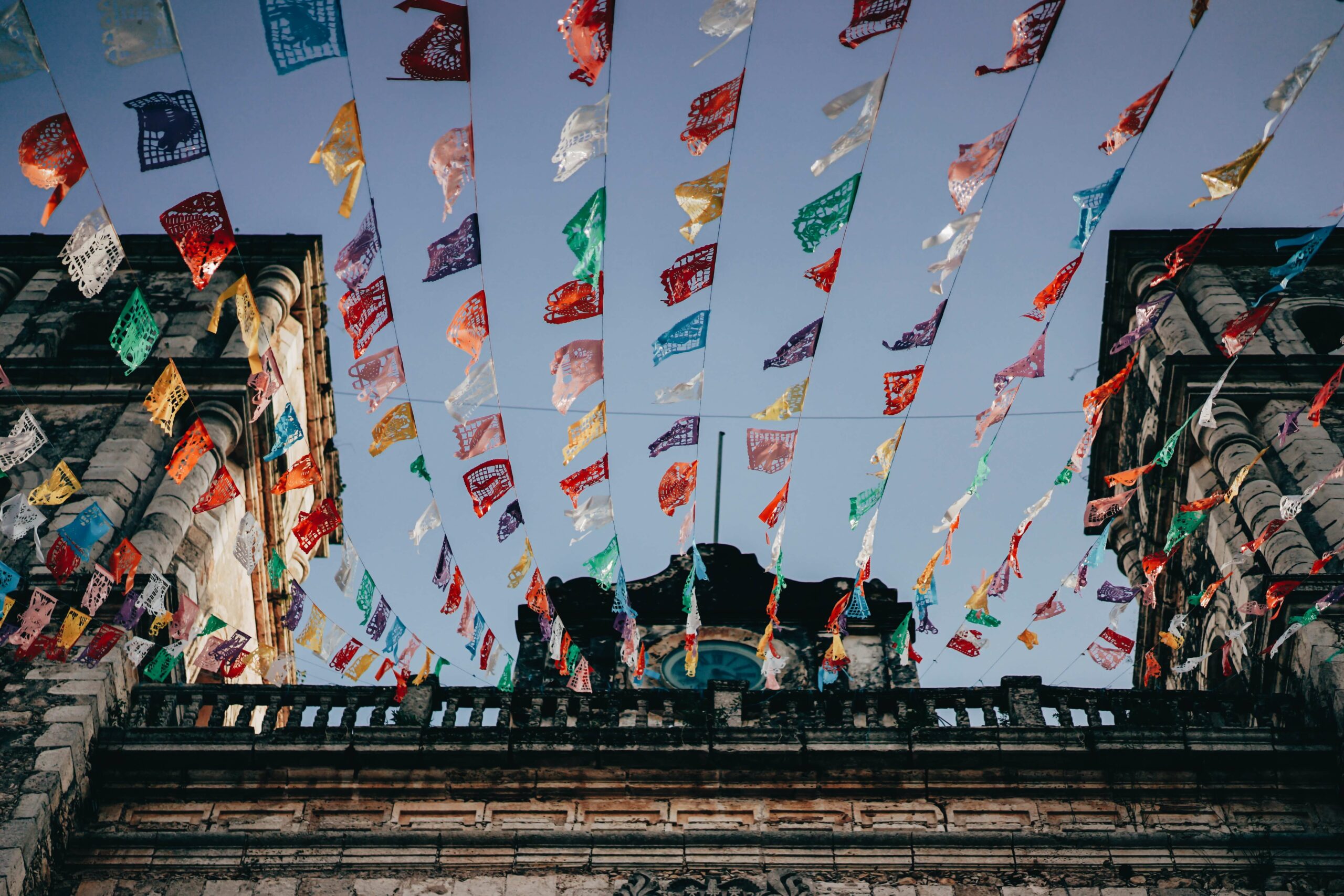Mexico is a country with a rich cultural heritage and many fascinating traditions, and nowhere is this more apparent than with Mexican wedding traditions.
A Mexican wedding is often a big, multi-day family affair, where music, food, dancing, and celebration are shared well into the night.
The majority of people in Mexico are Roman Catholic, so Mexican weddings incorporate many of the religion’s traditions.
However, some couples may draw on traditions from the country’s many indigenous cultures, such as the Mayans or Zapotecs.
Whether you are attending your first Mexican wedding or your 50th, there is always something to learn about the fascinating traditions of Mexican wedding culture.
16 Mexican Wedding Traditions and Rituals
Ceremony Traditions
A traditional Mexican wedding ceremony features a Catholic mass, which encapsulates several traditions. I’ve compiled a list of some things you might see when attending a traditional Mexican wedding ceremony.
1. The Church
Most traditional Mexican weddings take place inside a church. For many Mexican communities, the church is “the house of God” and is an important religious and cultural pillar. Marriage is one of seven holy sacraments, like baptism and confirmation, making a church essential for a traditional wedding in Mexico.
In Mexico, as in many Catholic countries, marriage is not just between the man and the woman, but also between the couple and God.
2. Padrinos y Madrinas
“Los Padrinos y Las Madrinas” are like god parents for weddings. They are usually family members (or at least close to the bride and groom) tasked with performing special roles in the ceremony. There is no limit on how many padrinos and madrinas a wedding might have.
Often, the individuals chosen exemplify the kind of commitment or relationship the bride and groom aspire to have. Asking someone to be a padrino or madrina at a wedding is seen to be a great honor.
Padrinos and madrinas perform several rituals throughout the occasion. They might do a reading or dedication, sponsor a portion of the wedding, or purchase things like decorations, candles, or other items used during the ceremony.
3. Other Family Members
A Mexican wedding is a time for family. I’ve seen guest lists number in the hundreds, and the event is treated as a family reunion. Even if the bride and groom are primarily English speakers, the ceremony is often performed at least partially in Spanish for those family members who may not speak English.
Both parents accompany the bride and groom down the aisle to symbolize that they consent to the marriage of their children.
4. Mass
The ceremony itself is usually about an hour long and is similar to a regular Sunday mass, except that it includes the marriage rites. These rituals include the vows, the blessing of the 13 coins, “el lazo,” the nuptial blessing, “la ofrenda,” and the use of kneeling pillows for prayer.
Kneeling pillows are sometimes gifted by the padrinos or madrinas, and serve as a keepsake for the bride and groom to remember the day. The vows follow traditional Catholic customs that demonstrate the bride and groom’s intentions to honor each other and God.
5. Communion
After the couple says their vows, they take communion together. Taking communion as their first meal together signifies their reliance upon God and their faith in him to provide for them. After the bride and groom are done, guests are also invited to take communion.
Guests who are not Catholic are technically not supposed to take communion, so it is perfectly acceptable to stay in your seat during this part of the ceremony. However, most priests will happily bless you and allow you to participate if you want to.
6. El Lazo
“El Lazo,” or “the lasso” is a large rope, rosary, or silk cord that ties the couple together after they have said their vows. The padrinos and madrinas purchase the lasso and place it around the couple during the unity ceremony.
The unity ceremony, during which the bride and groom are bound together, symbolizes the couple’s new status as “one” in the eyes of the Lord. In addition, it signifies their new duty to support each other and work together to make the marriage work.
7. Las Arras Matrimonias
After the couple has said their vows, the groom presents 13 gold coins to his bride as a gift. The padrinos and madrinas purchase the coins, and the priest blesses them before the groom presents them. They symbolize Jesus and his 12 apostles and signify the groom’s commitment to providing for and supporting his wife.
The gold coins also symbolize that the bride and groom’s fortunes are now shared and that all their worldly treasures and possessions have become one.
8. The Nuptial Blessing
The nuptial blessing is a prayer the priest recites at the end of the ceremony to unite the couple and ask God to watch over them and provide for them. When the nuptial blessing is part of the mass, it comes after the Our Father. However, it can be done outside the mass. Some ceremonies that do not include the mass may still include the nuptial blessing as one of the most enduring Mexican wedding traditions.
9. La Ofrenda
Rather than throwing the bouquet over her shoulder, as may be done in an American wedding, a Mexican bride will offer the bouquet to the Virgin Mary and ask for her blessing or say a prayer. This custom typically happens after the ceremony, on the way out of the church.
10. Mariachis
I love mariachi music, and it’s a big part of Mexican weddings, not only as part of the reception but also during the ceremony. During the ceremony, the couple might hire a mariachi band to play traditional songs and hymns, to play music to accompany their walk down the aisle, or to play a song for them to exit the church.
11. La Callejoneada
After the ceremony, it is tradition for the bride and groom to lead a parade to the reception location, accompanied by music from the mariachis. I’ve encountered similar traditions in places like Louisiana, where wedding parades that are known as “second lines” shut down entire city blocks.
“La callejoneada” is an opportunity for guests to stretch their legs after sitting through the long ceremony. It helps to transition the wedding party and guests away from the formality of the mass to the fun party atmosphere of the reception.
The Reception
After the ceremony comes the reception— I can vouch that a Mexican wedding reception is often an all-night affair! Dinner tends to be served late. Music, food, and dancing happen well into the early hours of the morning or even into the next day. Even children get special permission to stay up late, while grandparents also join in the nighttime revelry.
12. First Dance
As with nearly all wedding receptions, the first dance is reserved for the bride and groom and their families. The happy couple may dance with their parents and padrinos first to honor them before they have their first dance together. Afterward, guests are invited to join the couple on the dance floor.
13. Money Dance
A less well-known tradition is the “money dance,” where female guests pay to dance with the groom, and male guests pay to dance with the bride. In another version, guests might shower the bride and groom with money while dancing.
Not every couple includes this dance in their wedding, as some people feel uncomfortable asking guests for money. However, when it is approached from the angle of honoring a long-standing tradition, I would say the custom can be a fun, silly way for guests to interact with the bride and groom and show their support.
14. La Vibora de La Mar
“The Sea Viper” dance involves the bride and groom standing on chairs facing each other and forming an arch, while guests pass underneath like a snake. The goal of the dance is not to break the snake. As the dance progresses, the music gets faster, with it getting harder not to break the chain.
As with the money dance, guests might pass money to the bride and groom or pin cash to their clothes as a sign of support.
15. Food and Drink
From my happy experiences alone, food and drink play a prominent role in a traditional Mexican wedding. Savory meat courses like chicken, pork, and beef are served, along with side dishes like enchiladas, moles, chile peppers, and tortillas. Many weddings feature an open bar with copious tequila shots and margaritas, which I recommend experiencing at least once! Sangria is another popular traditional choice.
Mexican wedding cakes are often rum-soaked fruit cakes with pecans or almonds mixed in. “Pastel de almendra,” or almond cake, is also frequently served at Mexican weddings.
16. La Tornaboda
La tornaboda, or the after-party, is a small family affair, sometimes held the next day. It gives close family members a chance to have one-on-one time with the bride and groom. This intimate after-party is a time to exchange gifts, share food, and reminisce about memories made the night before. La tornaboda is important, as family is central to Mexican wedding traditions.




